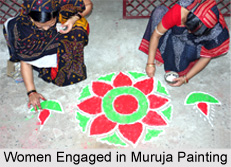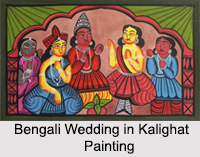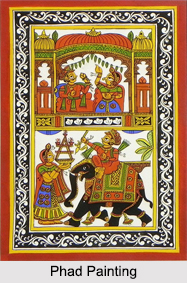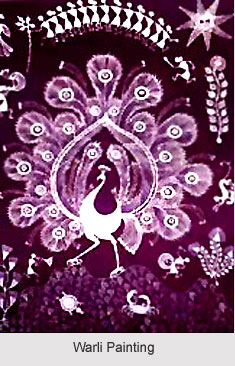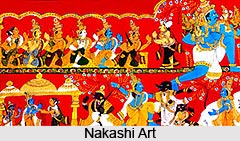 Nakashi is a type of scroll painting, which depicts scenes from mythology and folk traditions. The scrolls consist of panels depicting various scenes from Krishna Leela, Ramayana, Shiv Purana and Mahabharata. This art form is practiced in Cheriyal of Warangal district of Andhra Pradesh. Also popular as Cheryala scroll paintings, the unique thing about these paintings is that they are mostly done in bright, vibrant colours. They have a distinct Telangana flavour in their form and depiction.
Nakashi is a type of scroll painting, which depicts scenes from mythology and folk traditions. The scrolls consist of panels depicting various scenes from Krishna Leela, Ramayana, Shiv Purana and Mahabharata. This art form is practiced in Cheriyal of Warangal district of Andhra Pradesh. Also popular as Cheryala scroll paintings, the unique thing about these paintings is that they are mostly done in bright, vibrant colours. They have a distinct Telangana flavour in their form and depiction.
History of Nakashi
Scroll paintings have a rich history and play an important role in the Indian artistic tradition. Nakashi art is believed to have been developed by Usta artists from the Mughal empire who brought it to India during their rule. The origins of this form of art came from the ancient paintings seen in the historical temples of the region. They later spread in the form of cloth paintings and were used as an efficient tool to make story telling more powerful.
The Tradition
The traditional art form became a part of the profession of story-telling. The balladeer community is known as the "Kaki Padagollu". In a typical recitation, the balladeer would wander from village to village in a team of usually five people, with two to narrate the story while the others would provide a simple music accompanied with harmonium, tabla and castanets. They displayed the scrolls and narrated the ballads based from their rich folklore which was rooted in the Puranas and Indian Epics.
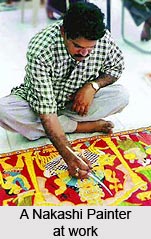 Artists of Nakashi
Artists of Nakashi
This 500 year old ancient form of painting has a handful of practitioners. Sri D. Vaikuntam of Cheriyal is the last bastion of this art and has been painting for more than three decades. Born into a family where the Nakashi art was passed on hereditarily, Nakashi Venkataramaiah"s family is perhaps the only and last family to pursue this art form. Presently D.Vaikuntam and his sons D.Rakesh & D.Vinay are working in this craft. In the olden days, the painters were given dried coconuts and rice as their fee. Today, currency exchanges hands but the ritual of presenting dried coconuts as a token of appreciation still continues.
Process of Nakashi
This form of art has beautiful borders and usually comes in bright colours like yellow, green and blue with the background mostly dominated by red. Khaddar clothes are cut to sizes of required dimensions. They are made stiffer by applying a mixture of boiled rice paste, tamarind seed paste, white clay and gum in three coats. After the canvas has dried completely, the artist uses a squirrel brush and creates a free hand design with red oxide paste called "geru". The Nakashi paints are created using only natural colors. Lamp soot is used for black shades, seashells for white, while the vibrant red color comes from Inglicum, an Ayurvedic product. The natural colors are mixed manually using mortar into a thin, fine paste. They are dried and stored away and portions are taken out as and when needed. Dolls and masks are made of wood, saw dust and tamarind paste. Masks are made even with coconut shells. The Nakashi scrolls and dolls were used for narrating stories in ancient times. Now it is found adorning the walls of South Indian homes.
Nakashi Art at Different Regions
In India, each region and village developed its own scroll painting traditions, marked by characteristic content, form and technique depending on the local ethos, patronage and socio-economic conditions. Rajasthan is known for its "Pabuji ki Pad", "Devenarayana katha" as also stories from the legend of "Dhola and Maru". Goa evolved the "Dasavathara", as Maharashtra did "Pinguli" and the "Chitra Katha" traditions. Maharashtra and Gujarat are also known for a sophisticated scroll painting tradition called the "Prasasti Patra". Orissa and Bengal are famous for their Patachitra traditions

